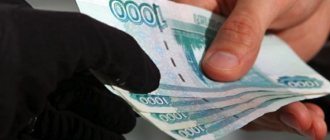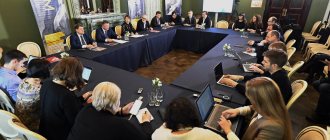Fraud is a criminal offense, a type of theft. It is characterized by extorting money from the victim through deception and abuse of trust. In fact, the criminal, by his actions, only directs the victim, encouraging him to voluntarily, but unknowingly, transfer his property. This act does not involve causing harm to the health or life of the victim.
Like any other socially dangerous violation of the law, a crime against property by deception is prosecuted by law. Do not confuse the composition of Art. 159 of the Criminal Code of the Russian Federation with an administrative offense provided for in Art. 7.27 Code of Administrative Offenses of the Russian Federation.
Note!
If the damage does not exceed 2,500 rubles, then fraud does not constitute a criminal offense and is punishable by an administrative fine, arrest or compulsory labor.
Fraud is an exclusively intentional crime, because... it cannot be done accidentally through negligence. The composition requires the presence of an action plan, as well as a strategy for deceiving the victim.
If you discover a violation of the law, it is important to report the incident in a timely manner in order to increase your chances of restoring your violated rights. In addition, financial scams are crimes for which criminal prosecution can be initiated only if there is a statement from the victim, which indicates a private-public order (Article 20 of the Code of Criminal Procedure of the Russian Federation).
Reporting a crime is the main tool in the fight for one’s own violated rights. It must be submitted to the police, where it will be registered and initiate investigative actions. In addition, the victim can contact other law enforcement agencies - the prosecutor's office or the Investigative Committee. The general rule for determining the investigative jurisdiction of criminal investigations is enshrined in Art. 151 Code of Criminal Procedure of the Russian Federation. The Investigative Committee has the right to begin a preliminary investigation if it has identified this crime, and in the case of a special procedure (Article 447 of the Code of Criminal Procedure of the Russian Federation). Also, the prosecutor is authorized at any time to withdraw the case from the police and transfer it to the Investigative Committee of the Russian Federation (Article 37 of the Code of Criminal Procedure of the Russian Federation).
Applying for state protection requires compliance with a number of established as well as unspoken rules, which we will describe in our article.
What it is?
To prove fraud, you first need to know for sure - is the attack a fraud and not something else? In criminal law, fraud is defined as the theft of someone else's property or the acquisition of rights to someone else's property, committed by deception or abuse of trust. From the definition it follows that:
- Fraud is a type of theft.
- Not only theft, but also the acquisition of rights to property is fraud.
- By deception - this is telling the victim some false information or keeping silent about something important or significant.
- In case of abuse of trust, the fraudster deliberately wins over the victim, receives important documents or information from him, and uses them for personal gain.
Here are two illustrative examples.
Example 1 . Two citizens were traveling on a train. We met, started talking, and it turned out that the first was going to city N to buy a house, and the second introduced himself as the owner of a house that he would like to sell. When inspecting the house, the buyer was satisfied and decided to buy it. The seller asked for a deposit, and the buyer gave the fellow traveler a significant amount. The unlucky buyer never saw this citizen again. The house belonged to another person.
Example 2 . Citizen “A” was selling her house. Buyers came, examined, but did not buy. Finally, a buyer was found. After the sale, one of the buyers who had previously inspected the house reported to the police that the deposit had been transferred to “A”. Which she denies receiving. A criminal case was opened and an investigation was carried out, but no crime was found in the actions of “A”.
In the first example, deception is visible - someone else’s house is passed off as your own. This is a fraud. In the second, the seller was actually selling her house. There was no deception or breach of trust. It is unknown whether she took the deposit; the applicant has no supporting documents. If she did, then this is a civil transaction.
Subsequent investigative actions
At the next stage of the fraud investigation, the investigator systematizes and analyzes the collected materials of the criminal case, draws up detailed plans, auxiliary diagrams and tables, appoints forensic examinations, carries out additional interrogations of the accused and confrontations with their participation, takes measures to expand the witness base, conducts identifications and investigative experiments . At this stage, the investigator’s work is structured in the following areas: checking the received evidence of the fraudsters’ guilt; collecting new evidence; identification of previously unknown episodes and accomplices of fraud; search for escaped criminals; search for funds obtained as a result of fraud, as well as property and valuables acquired by criminal means; studying the identity of the accused; establishing the causes and conditions that contributed to the commission of fraud.
Let us consider in more detail the investigative and some other actions of the investigator at the subsequent stage of the investigation.
The range of forensic examinations carried out in this category of criminal cases is quite wide and depends on the method of fraud and the circumstances to be clarified.
To expose fraudsters, fingerprint examinations are carried out in relation to the handprints they left during the commission of a crime, traceological examinations - if it is necessary to establish the whole of the packaging or the contents of the “dolls”; physical and chemical (gemmological) examinations – in cases of sale of counterfeit jewelry. When committing fraudulent actions, veiled by financial and economic transactions, a forensic accounting examination may be carried out.
Documents are sent for handwriting examination to identify the executors of signatures and individual entries, additions, and the entire text as a whole. In these cases, signatures under the constituent documentation of the enterprise, agreements and contracts, receipts, additions to expenditure and receipt documents are subject to examination; handwritten texts in draft notes of scammers.
To establish the fact and methods of forgery of typewritten, printed and other documents and their details, a technical and forensic examination of documents is assigned. Technical and forensic examination of documents reveals facts and methods of manufacturing counterfeit securities, licenses, quality certificates, payment orders, credit cards, banking and financial accounting documentation, passports and IDs. The subject of the research may also be technical means used in forging and using false documents: photocopiers, fax modems, teletypes, printers.
In connection with the widespread introduction of automation tools in the field of management, accounting and settlements of Russian enterprises, the use of computers for collecting, systematizing and managing various information is becoming widespread, including in cases related to fraudulent actions carried out on behalf of legal entities. Thus, of interest to the investigation are the data entered into the computer about the financial transactions carried out, the actual availability of collected funds, the composition of shareholders or investors, etc. In such situations, there is a need to perform a computer forensic examination, which has the ability to identify the user and programmer of the computer, restore altered information arrays, identify the fact and determine the method of unauthorized penetration into the computer system.
Additional interrogations of the accused are carried out in order to clarify and detail the testimony given at the initial stage of the investigation, on the circumstances of previously unknown episodes of fraud, to obtain explanations for the documents presented for the first time, as well as the conclusions of forensic examinations carried out in the case. In addition, a thorough interrogation of fraudsters on all episodes and circumstances of the crime committed is carried out after the final charges are filed.
Identified contradictions in the testimony of the accused about their participation in committing fraud are eliminated by confrontation, as well as by carrying out other investigative actions.
During the investigative experiment, the ability of the accused to perform actions included in the structure of the fraud mechanism, as well as other operations, is tested. These include: production of counterfeit documents and auxiliary technical means; manipulations to seize the property of the victim; the opportunity to observe certain actions, etc.
In the course of work to find the property of the accused, carried out in order to compensate for the material damage caused and ensure possible confiscation, the investigator conducts searches, seizes property and postal and telegraph correspondence, and sends requests to organizations and institutions. The search for housing owned by the accused includes departments for accounting and distribution of living space, technical inventory bureaus, notary and real estate offices, real estate exchanges, and housing privatization departments. In rural areas, the availability of private houses, dachas, cottages and land plots is established by local authorities. The traffic police has information on the acquisition, use and sale of vehicles, and you can also find out about the import of foreign cars from abroad from the Customs Committee.
The fact that the accused acquired registered securities is recorded in the registers of the issuing company. A joint stock company takes into account the shares it issues and their certificates, banks - checks and savings books, certificates of deposit, credit cards, bills.
The tax office finds out whether the accused submitted an annual income declaration and its contents, on what property and vehicles he paid taxes.
The investigator learns about the availability of real estate abroad, investments in foreign companies and banks by contacting the National Central Bureau of Interpol of the Ministry of Internal Affairs of the Russian Federation.
After the discovery of property belonging to the accused, measures are taken to preserve it until a court decision. Valuables and money are transferred for safekeeping to the financial departments of the internal affairs bodies, cars are placed in special parking lots of the traffic police. Furniture and other items located in the apartment are included in the inventory of the seizure of property. Securities are subject to withdrawal with mandatory notification to the issuers who issued them about preventing the movement of funds associated with them (issuance of dividends, return of deposits, payment of bills). Suspend payments on a plastic card registered to the accused, possibly by sending a request to the banking and financial organizations using them to include this card in the so-called “stop lists” (lists of invalid cards). If the fraudsters have funds in ruble and foreign currency accounts in banks, orders of seizure are sent there.
In addition, seizure is imposed on the property of fraudsters, leased to other legal entities or individuals, as well as the subject of collateral.
Areas and examples of evidence of fraudulent activities
In 2012, a number of articles differentiating liability for fraud were introduced into the Criminal Code of the Russian Federation.
This is due to the specifics of certain types of activities and the emergence of new ways of committing crimes. The following legal norms were introduced:
- Article 159.1 fraud in the field of lending;
- Article 159.2 fraud in receiving payments;
- Article 159.3 fraud using electronic means of payment;
- Article 159.4 fraud in business activities (deleted);
- Article 159.5 insurance fraud;
- Article 159.6 fraud in the field of computer information.
- Article 159.1 provides for criminal liability in relation to borrowers who provide the lender with knowingly false and unreliable information: fictitious constituent documents, agreements with a shell company, dummies, etc. Liability is based on deception. The presence of shell companies and fictitious commercial documents is not difficult to prove. It is necessary to conduct a small audit, examination, identify and interrogate witnesses.
- Under Article 159.2, liability has been introduced for receiving various social payments and benefits using fictitious documents. Fraud is often committed in relation to pensions. False information about work experience or documents about fictitious disability are provided. Intent is proven by the testimony of witnesses, the fraudster himself, and various examinations.
- Article 159.3 provides for liability for fraud in the field of electronic payments. These are telephone scammers who ask close relatives to deposit money to pay for the phone or make other payments. Bank card fraud is common. It is difficult to prove a crime, but it is possible with the help of testimony, examinations, videos and photographs.
- Article 159.5 provides for liability for insurance fraud. For example, deception regarding the occurrence of an insured event. There are many known facts when an insured car is stolen and the property insured against fire burns down. An inspection is underway. If there was no theft, but the wrong property was burned, then this is a reason to initiate a case under Article 159-5 of the Criminal Code of the Russian Federation. During the investigation process, any standard evidence is used: witness statements, photo and video recordings, etc.
- Article 159.6 establishes liability in the field of computer information. The fraud is committed by entering, changing and erasing the victim's computer data. The information obtained in this way forms the completed crime. It can be proven with the help of video and photographic recordings or with the help of ordinary evidence: witness testimony, seizures, searches, inspection.
Entrepreneurial activity
Entrepreneurship is impossible without concluding agreements with business partners. A party to a transaction assumes obligations. If they are not fulfilled, the other party bears losses. The fact of causing harm is the subject of investigation . If it is proven that the entrepreneur had no intention of fulfilling his obligations, intent and corpus delicti are established.
When collecting evidence, the contract is examined for amendments. Through questioning witnesses and audits, the possibility of its implementation is established.
The totality of the collected evidence confirms criminal intentions and is the basis for criminal prosecution.
Fraud involving a legal entity
Fraud involving an organization means any of its relationships as a subject of civil relations, if as a result one of the parties unreasonably tries to enrich itself at the expense of the other. That is, this is the same fraud, only one of the parties (or both parties) is a legal entity.
In other words, fraud involving a legal entity involves an organization receiving funds from citizens or other legal entities that do not belong to it, as well as receiving benefits or subsidies without sufficient grounds. Fraud in relation to such is the unjust seizure of the organization's property by other persons.
Punishment for certain types of fraud involving legal entities is also provided for in Articles 159.1, 159.3, 159.5 and 159.6.
General types of evidence
The collection and assessment of evidence is carried out during the investigation of a criminal case . The evidence with the help of which conclusions are drawn is listed in the Criminal Procedure Code of the Russian Federation. They are divided into types:
- Testimony of the accused, suspect.
- Conclusion and testimony of a specialist and expert.
- Records of judicial and investigative actions.
- Testimony of a witness, victim.
- Evidence.
- Other documents.
- Testimony of the accused, suspect . During the investigation, a suspect is identified. He is being interrogated. If there is evidence, they are charged and interrogated as an accused. The suspect-accused has the right not to testify, to admit or deny guilt. The chosen position is assessed by the investigator and the court.
- Conclusion and testimony of a specialist and expert . If necessary, a specialist in any field of knowledge may be involved in the investigation or an examination may be assigned. If there is any ambiguity in the specialist's report or the expert's conclusions, they are questioned.
- Records of judicial and investigative actions . A protocol is drawn up for such investigative actions as inspection of the crime scene, examination, seizure, search and a number of others. All actions reflected in the protocol are subject to evaluation and influence the recognition of a person as guilty or innocent.
- Testimony of a witness, victim . A witness or victim may make a mistake or misunderstand something. On the same fact, different witnesses may give contradictory testimony. However, witness statements in a criminal case are important evidence. Often a conviction is based on their testimony.
- Physical evidence is any object of the material world that contains information about the crime committed. They can be: things and valuables obtained by criminal means (money, precious metals). Physical evidence is difficult to falsify - it is the most objective evidence.
- Other documents . These include various kinds of certificates, acts, characteristics and personal letters. Documents can be on paper or in photographs and videos.
Features of tactics of initial investigative actions
The interrogation of the victim is carried out on the following range of questions: where, when, through whom, under what circumstances the victim met the fraudster (with the company on whose behalf the fraudulent actions were carried out), what purpose he pursued; what the fraudster promised the victim, what he demanded and what he received from him, what he sold to the victim; how many times the meetings took place, where, at what time, for how long; whether the fraudster was alone or as part of a group, what was the participation of each person in the fraud; how the scammer was recommended, did he show any documents; what was the material damage to the victim; signs of money or things transferred by the victim to the fraudster; who can confirm the circumstances of the fraud.
Particular attention is paid to finding out information about the identity of the criminal: his external signs, including special features, habits, clothing, and manner of speaking. When a fraudster uses a car, its make, color, number, and distinctive features are described.
The questioning of witnesses is aimed at finding out: the circumstances of the fraud; data about the signs of the fraudster, his personality, activities, lifestyle, behavior; information about each member of the criminal group; information about the identity of the victim, his interest in the transaction; information about the nature of the transaction, the property transferred by the fraudster to the victim; other facts of fraud and circumstances that contributed to this crime.
In cases of fraudulent real estate transactions or misappropriation of funds from private investors, managers, accountants, secretaries, cashiers, and security guards of the relevant companies can act as witnesses; notaries, housing and communal services workers, passport offices and other categories of employees.
When investigating fraud, the opportunity to inspect the crime scene should not be overlooked. It is advisable to conduct it with the participation of the victim. This allows you to navigate the situation of the crime, check the credibility of the applicant’s testimony regarding the place and conditions of the fraud, and, under favorable circumstances, find traces or individual items left by the criminal; get an idea of the possible range of witnesses and how to identify them.
In cases of participation in fraudulent activities of commercial structures, inspections of their office and production premises, cash desks, and accounting departments are carried out.
Items left or transferred by the fraudster are immediately inspected. The data obtained in this case is included in the search orientation and is used to search for the fraudster.
Documents remaining with the victim after committing fraudulent actions are subject to thorough inspection. These can be securities and their surrogates, certificates of ownership, agreements and contracts, copies of financial personal accounts and extracts from house books, certificates, receipts.
A forensic specialist is included in the number of participants in the investigative examination to identify and record traces of hands, microparticles, and signs of document forgery. Other specialists may include jewelers, merchandising experts, and accountants for the inspection.
It is advisable to detain the suspect red-handed. This is possible in cases where a criminal case is initiated on the basis of operational investigative measures carried out by the body of inquiry, or when a fraudster, in respect of whom there is a statement or testimony from victims, is systematically engaged in fraudulent activities. In the process of preparing for detention, the issue of the formation and composition of the detention team, technical means of documenting the actions of the fraudster and his accomplices, the sequence and order of further investigative actions are resolved. It is advisable to make an arrest after the fraudster takes possession of the victim’s property or money.
The results of a tactically correctly conducted interrogation of the suspect are essential to the case. In preparation for this investigative action, it is necessary to study the mechanism of the crime, the personality characteristics of the fraudster, his past criminal experience, the presence and nature of the collected evidence, and establish the role and functions in the criminal group.
If the suspect admits the fact of fraud, he will find out: when, where and under what circumstances the fraud was committed; what information he has about the identity of the victim, under what circumstances he met him; how the fraud was committed, how it was prepared and what measures were taken to conceal it; who are the accomplices in the crime, their role in the implementation of the criminal plan; what property and valuables were received from the victim, where they are stored or under what circumstances and to whom they were sold; what other crimes have been committed by the suspect and the criminal group to which he belongs.
If the fraudster denies his guilt, he is presented for identification to the victim and witnesses, confrontations are held, and forensic reports are presented.
During the investigation, it may be necessary to seize the accounts of a company involved in fraudulent transactions. In this case, the investigator makes a reasoned decision in relation to the relevant business entity and sends it to a commercial bank or an institution of the Central Bank. The bank is obliged to stop all financial transactions with the funds of the enterprise whose accounts have been seized.
Relevance and admissibility of evidence
According to Art. 59 of the Code of Civil Procedure of the Russian Federation “The court accepts only that evidence that is important for the consideration and resolution of the case.” Materials not related to the circumstances of the case are excluded from the list of evidence. The remaining evidence must be admissible.
Inadmissible evidence is listed in Art. 75 of the Criminal Code of the Russian Federation . They cannot be used as the basis for the accusation, but they cannot become evidence for the defense. This evidence has no legal force. The law refers to the following evidence:
- Testimony of a suspect or accused, given during the pre-trial investigation in the absence of a defense lawyer and not confirmed in court.
- Testimony of the victim, witness based on guesses, rumors, assumptions.
- Testimony of a witness who cannot confirm the source of his knowledge.
- Items, documents and information included in the lawyer’s proceedings.
- Other evidence obtained in violation of the law.
All interrogations of the suspect or accused must be carried out with the participation of a defense lawyer with whom an agreement has been concluded. Even in the event of a written refusal from the defense attorney, all interrogations of the suspect or accused will be inadmissible evidence.
Rumors, conjectures, assumptions cannot be used as the basis for accusations. Accordingly, the testimony of a witness and a victim based on conjecture cannot be admissible. A witness can talk at length and interestingly about something, but still not say how he knows it. Such a fruit of a far-fetched story cannot be recognized as evidence.
Since 2022, the law has prohibited the inclusion of evidence presented by a lawyer in criminal cases. The investigator is in charge of the case and collects evidence . A lawyer can act through an investigator or a court. Evidence collected by a lawyer independently is considered inadmissible.
The last fifth point of the list of inadmissible evidence includes other evidence obtained in violation of the law. This point is quite broad. It covers almost any evidence that was obtained in violation of the law. For example:
- evidence of criminal activity obtained as a result of a search conducted without witnesses;
- valuable documents obtained as a result of a seizure made by an investigator who was not allowed to participate in the proceedings.
If it is impossible to prove fraud
But it also happens that fraudulent actions cannot be proven. More often than not, this happens due to the fault of the victims themselves. We are talking about a debt without a receipt. Without a document confirming the loan, witnesses and materials that could at least indirectly prove the offense, it will be extremely difficult to bring the attacker to justice.
In such cases, lawyers advise resorting to peaceful negotiations and trying to come to an agreement with the person who borrowed the money. But if your conversation does not go well, and the attacker continues to deny the fact of receiving your money, then there is one more option.
Important! Peace negotiations cannot be evidence in court. There is no need to record them or take pictures of the correspondence of the conversations. Also, testimony cannot serve as evidence if the loan amount does not exceed 10 minimum wages.
If peace negotiations are unsuccessful, you should contact the police. But before this, you need to send a letter to the debtor with notification of receipt. The letter must indicate all the details of the case.
After the debtor receives the letter and cannot deny the fact of its receipt, you can file a statement with the police. It must indicate the date, time, place of transfer of money, the name and address of the debtor and the time that has passed since the moment the debt must be repaid. At the end of the application there must be a request to conduct a check of the suspect.
To identify signs of a crime, the debtor will be called to the police. If during interrogation the suspect states that he is going to return the money, then no criminal case will be initiated. In this case, the police will issue a resolution, which will become the main evidence in court if the debtor does not return the money within the prescribed period.
How can the fact of intent be confirmed?
Fraud is a crime that is committed with direct intent. The criminal’s actions are based on selfish interest. The fraudster acts either by deception or by breach of trust. Therefore, in order to prove intent, it is necessary to prove the fact of deception or the fact of abuse of trust.
Fraud is not difficult to prove. It is proven through the testimony of the victim, witnesses, seizures, inspections, and, if necessary, examinations are carried out. Let's remember the example of a house for sale, where a fraudster takes a deposit for the house he is supposedly selling. To prove intent, you must do the following:
- Request to the Rosregister about the ownership of the house.
- Questioning the owner to see if he handed over the keys to the house to anyone.
- Interrogation of the victim about the appearance of the citizen to whom the money was transferred.
- Identification of this citizen by the victim.
- Interrogation of the conductor of the carriage in which the victim and the fraudster were traveling.
The collected evidence will be enough to find the “seller” guilty. The scammer’s position – “I didn’t take any money” – is unlikely to “work”.
Example 3 . The fraudster acted by breach of trust. Citizen “B” was engaged in the sale of used cars for a long time. Many motorists knew him personally and entrusted him with the sale of their cars without drawing up the appropriate contracts. Powers of attorney were issued. However, they no longer saw their cars and the money from the sale either. The seller himself also disappeared. He was detained in another city.
Intent was proven by:
- Interrogation of victims.
- Copies of powers of attorney seized from the notary.
- Information on the re-registration of sold vehicles with the traffic police.
- Interrogation of witnesses - new owners.
The fraudster was found guilty of fraud by breach of trust and convicted. He actually sold cars, and he was not accused of deception.
Misappropriation and embezzlement
There are many differences between theft and fraud, misappropriation and embezzlement. The fact of appropriation can only be confirmed if the thief himself was entrusted with this property. The act implies the presence of self-interest.
Embezzlement is also a similar offense, but in addition to intent, it implies self-interest and waste of property, for example, transfer to third parties, consumption or expenditure.
The main condition for embezzlement and embezzlement is that the property is entrusted to the offender by its rightful owner. For example, in case of theft, property illegally falls into the hands of the thief, and in case of embezzlement or misappropriation, the owner, of his own free will, transfers it into the hands of the criminal.
The role of the receipt
Having a receipt in hand, you can go to court with a statement of claim. If the receipt is correctly drawn up, the court will recover money from the debtor, but it is unknown whether the creditor will receive his money. As a rule, the scammer does not have money.
If there is a receipt, there are no grounds for initiating a criminal case . Everything looks like a civil law relationship and there is no criminal intent.
If we consider the case in relation to one receipt, then the intent to commit fraud cannot be proven. But if you evaluate ten or twenty receipts, you will see ongoing fraud with direct intent.







